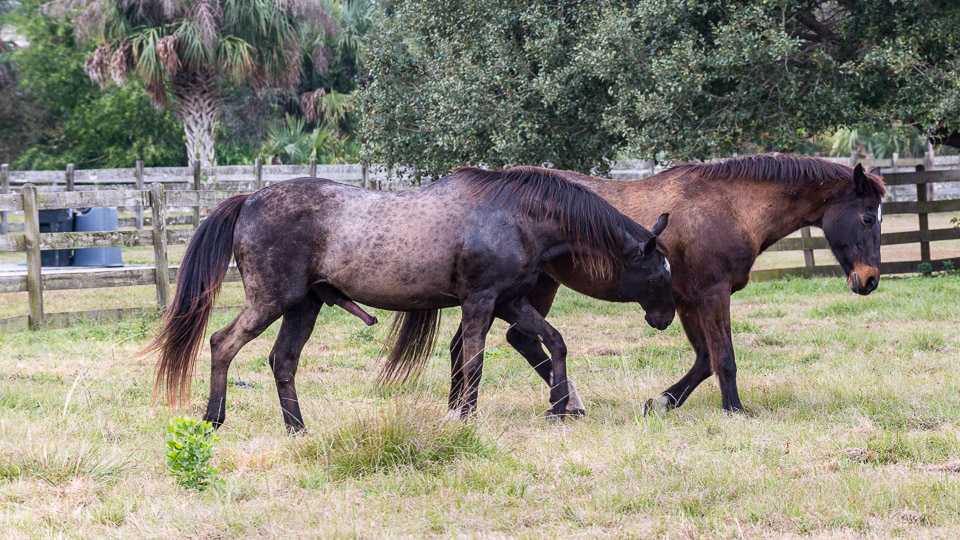
Horse Reproduction – An Introduction
The mating of a stallion and mare should be easy, right? It can be if you learn 1 secret – the necessity of observing the horses and recording these observations accurately. Accurate records reveal subtle patterns in mating behavior that can help in getting the mare to accept the stallion.
There are 2 types of breeding: natural and artificial. I have a series of images of my elder statesman gelding who was castrated late in life and continued to show good natural mating behavior, especially when turned out with his new girlfriend. This is called pasture breeding and it is the way nature intended it to occur. In breeding operations where only natural breeding is allowed yet a maximum return on effort is required for business, the stallion and mare are held by handlers trained in this very specific type of horsemanship. I will discuss this as my training before vet school was on a Thoroughbred farm where hand breeding was the only way allowed.
Artificial breeding details are beyond the scope of this website as the complexities are nuanced and detailed. However artificial breeding includes: 1) collection of the stallion either on a mare or a dummy mount, 2) the artificial insemination of the mare by a veterinarian, 3) the freezing or cooling of semen for shipment to other farms far away, 4) the collection of fertilized eggs and transfer of these ovums into recipient mares.
Complicating things include shy or aggressive mating behavior, venereal diseases, systemic viral diseases, acquired reproductive tract infections, attrition or damaged sperm and eggs, twin fetus development, birth canal damage and abortion (pre-term and full term). I’ll do what I can to touch on these topics but this subject could be a whole website. In my 12 years of full vet practice I have seen all of these topics and I will have several stories to illustrate them all.
Horse Reproduction – Artificial Insemination
An excerpt is coming soon.
Horse Reproduction – Breeding Injuries
An excerpt is coming soon.
Horse Reproduction – Caslick Surgery
An excerpt is coming soon.
Horse Reproduction – Embryo Transfer
An excerpt is coming soon.
Horse Reproduction – Estrous Manipulation
An excerpt is coming soon.
Horse Reproduction -Mare Cycles and Foal Delivery – a HorseTalk™ Webcast
This is a replay of a HorseTalk™ webcast. Be sure to enroll in the next one and join Doc T live.
Horse Reproduction – Mating Behavior
The mating behavior of horses is based on one stallion per herd of mares. In addition, the mares start cycling with increasing daylight (spring) and stop cycling as daylight decreases (fall).
Horse Reproduction – Stallion Testicles
The purpose of the testicles is to make and store sperm as they mature from infertile immature sperm formed in the testicle and move up the epididymis into the secondary reproductive organs where the semen is created. Because they are temperature sensitive and will die if warmed to body temperature, the testicles in mammals remain outside the body to keep the sperm’s temperature below body temperature.
Horse Reproduction – The Estrous Cycle
The mare has a seasonally poly-estrous breeding cycle. It is seasonal because it occurs during increasing daylight (spring) and does not occur with decreasing daylight (fall and winter). It is poly-estrous because they become receptive to mating (in heat) for about 6 days and then become unreceptive to breeding (out of heat) for about 15 days for a cycle of 21 days.
Horse Reproduction – Venereal Diseases
An excerpt is coming soon.
Foal Delivery – Red Sack Foal Delivery
The red sack foal delivery is really the premature separation of the foal’s placenta from the lining of the uterus. This diminishes the flow of blood to the unborn foal causing a lack of oxygen to the foal. Temporary to permanent brain damage and even death can occur. There is no time to call for help.
Foal Delivery – Elbow Lock
A normal foal delivery has both front hooves coming out of the birth canal with about 3 to 4 inches difference in the distance from the mare to the foal’s toe. With an elbow lock delivery, one limb is about a foot behind the other because the shorter limb is flexed at the elbow. This causes the foal’s diameter to become too big for the birth canal and the foal’s delivery is obstructed.
Foal Delivery – Retained Placenta In The Mare
An excerpt is coming soon.
Foal Delivery – Ruptured Uterine Artery In Mares
An excerpt is coming soon.
Foal Delivery – Rectal Vaginal Fistula In Mares
An excerpt is coming soon.


Responses